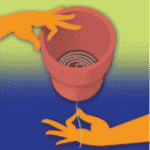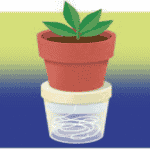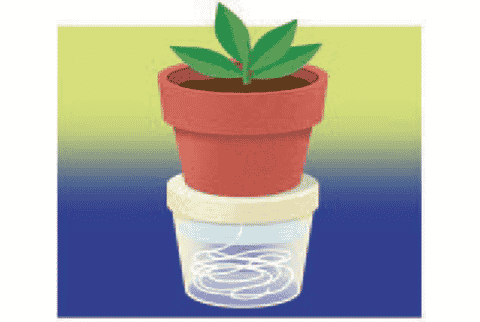Overview
STEM careers
Time
Materials
Per Group of 3-4 Students:
- 2-pint plastic container with lid (like for ice cream or yogurt)
- 1 potted plant, 6″ to 8″ in diameter
- Scissors
- Pen with a point
- Cotton string
- Newspaper
- Water
- Paper and pencils
Instructions
Students see adhesion and cohesion in action as they set up a system for keeping the soil of a potted plant moist for a week.
- Assign students to groups, distribute materials, and describe the challenge. Provide the following instructions:
- Poke a hole through the middle of the container lid with the pen, so that the string can go through easily.
- Fill the plastic container with water and soak about 18″ of string in it.
- Carefully take the plant out of its pot and set aside.

- Take the string out of the water. Coil the wet string in loops on the bottom of the empty plant pot. Run one end of the string through a hole in the middle of the pot’s bottom so that it hangs down at least 8″.
- Thread the hanging string through the hole you made on the plastic lid’s top, being sure the string does not lie on top of the lid. Fit the lid back on the container. The string will eventually drop to the bottom.
- Place your plant back in the pot, which should be resting on the lid. If the soil around the plant is dry, water it from the top once, just enough to dampen it.
- Over the next week, ask students to observe their plants, taking notes on the following questions:

- Does the soil stay moist?
- Does the plant stay healthy?
- Is there enough water in the reservoir to last the entire week?
Guiding questions
-
How will the water get to the plant’s roots?
-
What would happen if we didn’t wet the string first?
-
Do you think a thicker string would affect how long the plant stays watered? Why or why not?
-
What is another way you could use these materials to design a self-watering plant system?
-
How could you adapt this system to water more than one potted plant at a time?
Engineering & science connections
- Adhesion refers to the attraction of molecules to other kinds of molecules—for example, water molecules are attracted to the molecules that make up cotton string.
- Cohesion refers to the strong attraction of molecules to others of their same kind—for example, water molecules are strongly attracted to each other. They want to stay together and will sometimes even fight gravity to do it! Water is highly cohesive and clumps together into drops. For example, after you wax your car, you can see water droplets run off of it.
- Water has both cohesive and adhesive properties. In the natural world, cohesion and adhesion are the forces that allow water to be transported to a plant’s leaves and stem, and allow water striders and other insects to walk on water. Civil and environmental engineers must understand these forces when researching the amount of groundwater in soil, which impacts the stability of buildings and roads.
- The principles of adhesion and cohesion, as well as gravity and pressure, are used to ensure moisture does not get into the outside finishes of a building. Building materials are designed by engineers to ensure water does not adhere through cracks to the inside of walls where it can do damage or create mold.
This activity is from Three Cheers for Engineers!


0 Comments